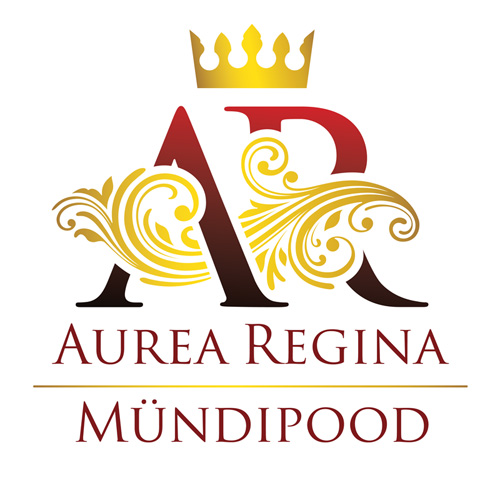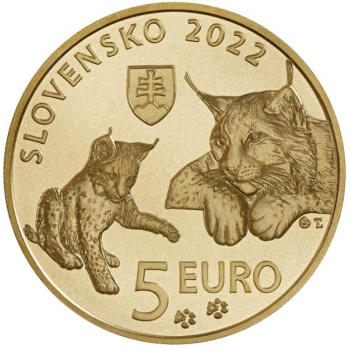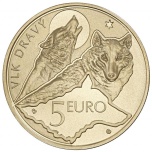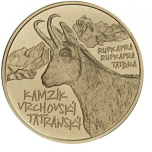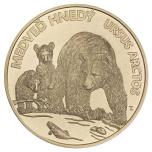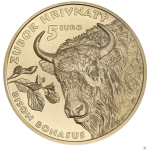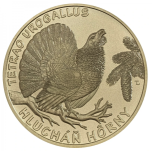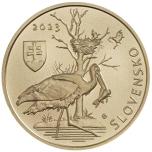Fauna and flora in Slovakia. the Lynx. Slovakia 5€ 2022 commemorative coin
Unit: tk
Price:
14,90 €
Face value: 5 €
Diameter: 34 mm
Weight: 19.1 g
Metal: Brass
Mintage: 35,000
3. coin from the series “Fauna and Flora of Slovakia”.
Obverse:
The obverse of this euro collector coin shows a lynx kitten on the left side and an adult lynx on the right side. Below the adult are the mint mark of the Kremnica Mint (Mincovňa Kremnica), consisting of the letters ‘MK’ placed between two dies, and the stylised letters ‘TL’, referring to the obverse designer Tomáš Lamač. The name of the issuing country ‘SLOVENSKO’ and the year of issuance ‘2022’ are inscribed along the upper left edge and part of the upper right edge. Below them is the Slovak coat of arms. The denomination and currency ‘5 EURO’ appear in the lower part of the design, above two lynx paw prints at the bottom edge.
Reverse:
On the reverse, filling the left and centre of the design, is a lynx’s head in profile. To the right of the image, on two lines, is the lynx’s scientific name ‘LYNX LYNX’, and below it are the stylised letters ‘LR’, referring to the designer of the reverse side Roman Lugár. Inscribed along the lower right edge is the lynx’s name in Slovak ‘RYS OSTROVID’.
‘The tiger of our forests’, ‘the phantom’: these are names that have been given to Slovakia’s largest wild cat, the Eurasian lynx (Lynx lynx). As an adult, the male weighs 24 kg on average and the female around 4 kg less. In the wild, the lynx can live for up to 17 years. The lynx’s particularly typical and unmistakeable features include tufts of hair on its ears, a black-spotted coat, and bobbed tail. It has excellent eyesight (as referenced in the second part of its Slovak name ‘rys ostrovid’) and superb hearing, but a less developed sense of smell. Generally living and hunting individually, the lynx is agile and can jump well and far. The lynx is in fact a very shy animal that never attacks humans. In the past, the lynx was hunted by the nobility for its valuable pelt and its claws were used in folk medicine. It used to be severely persecuted and was almost hunted out of the territory of what is now Slovakia, surviving until today only in small numbers in the central northern part and in the Eastern Carpathians. Since 1999 the lynx has had year-round protected status in Slovakia. As well as being a treasure of the country’s natural heritage, lynxes in Slovakia are also a source population for efforts to strengthen the species’ presence in other European countries.
Diameter: 34 mm
Weight: 19.1 g
Metal: Brass
Mintage: 35,000
3. coin from the series “Fauna and Flora of Slovakia”.
Obverse:
The obverse of this euro collector coin shows a lynx kitten on the left side and an adult lynx on the right side. Below the adult are the mint mark of the Kremnica Mint (Mincovňa Kremnica), consisting of the letters ‘MK’ placed between two dies, and the stylised letters ‘TL’, referring to the obverse designer Tomáš Lamač. The name of the issuing country ‘SLOVENSKO’ and the year of issuance ‘2022’ are inscribed along the upper left edge and part of the upper right edge. Below them is the Slovak coat of arms. The denomination and currency ‘5 EURO’ appear in the lower part of the design, above two lynx paw prints at the bottom edge.
Reverse:
On the reverse, filling the left and centre of the design, is a lynx’s head in profile. To the right of the image, on two lines, is the lynx’s scientific name ‘LYNX LYNX’, and below it are the stylised letters ‘LR’, referring to the designer of the reverse side Roman Lugár. Inscribed along the lower right edge is the lynx’s name in Slovak ‘RYS OSTROVID’.
‘The tiger of our forests’, ‘the phantom’: these are names that have been given to Slovakia’s largest wild cat, the Eurasian lynx (Lynx lynx). As an adult, the male weighs 24 kg on average and the female around 4 kg less. In the wild, the lynx can live for up to 17 years. The lynx’s particularly typical and unmistakeable features include tufts of hair on its ears, a black-spotted coat, and bobbed tail. It has excellent eyesight (as referenced in the second part of its Slovak name ‘rys ostrovid’) and superb hearing, but a less developed sense of smell. Generally living and hunting individually, the lynx is agile and can jump well and far. The lynx is in fact a very shy animal that never attacks humans. In the past, the lynx was hunted by the nobility for its valuable pelt and its claws were used in folk medicine. It used to be severely persecuted and was almost hunted out of the territory of what is now Slovakia, surviving until today only in small numbers in the central northern part and in the Eastern Carpathians. Since 1999 the lynx has had year-round protected status in Slovakia. As well as being a treasure of the country’s natural heritage, lynxes in Slovakia are also a source population for efforts to strengthen the species’ presence in other European countries.
Kollektsioon
Face value: 5 €
Diameter: 34 mm
Weight: 19.1 g
Metal: Brass
Mintage: 35,000
2. coin from the series “Fauna and Flora of Slovakia”.
Over the millennia of human society’s evolution, wolves have often coexisted with people. During the Middle Stone Age (Mesolithic), wolves began living in the vicinity of prehistoric hunters’ settlements and fed off meat leftovers. Wolves are found in various northern hemisphere habitats and are the second most widespread mammal on earth, after humans. They are a social animal, and their packs typically have between five and seven members. Weighing between 30 and 70 kg, wolves are classified as large carnivores. They have exceptional senses of smell, sight (night vision) and hearing, which they use to prey mainly on large ungulates. The way that wolves relentlessly run down their prey is captured by a Russian saying: “The wolf is kept fed by its feet”. This way of hunting was well applied in the forest-steppe environment where wolves evolved. Their pack structure allows wolves to hunt prey that are several times larger than themselves (such as red deer and elk) and to raise, on average, between four and ten pups each year. Food from the kill is shared between all members of the pack. All the adult pack members help with the care and rearing of the young by bringing them food. Altruism, in other words gratuitous service to others, is seen among wolves in the way they care for injured members of the pack. This feature is characteristic of evolutionarily advanced societies of other mammals: primates and human beings. The number of wolves in Slovakia is currently estimated to be between 300 and 600. Since Slovakia shares its wolf population with Ukraine, Poland and Hungary, it is difficult to give a more precise estimate of the number of wolves present in its territory.
Obverse:
The obverse of this euro collector coin shows an outline map of Slovakia in the lower part of the design. Contained within the map are the Slovak coat of arms and the year of issuance ‘2021’. Three wolves are depicted standing on top of the map, and a smattering of wolf paw prints appear within the map and outside it. A star is shown at the top right of the design, and the name of the issuing country ‘SLOVENSKO’ runs along the edge of the upper left quadrant.
Reverse:
The upper part of the reverse portrays two wolves, one of which is howling at the moon. At the top, to the right of the moon, there is a star in the night sky. The lower part of the image consists of the outline of a wolf’s head, within which is shown the coin’s denomination ‘5’ and currency ‘EURO’. In the left part of this space are the stylised letters ‘JO’, referring to the coin’s designer Josef Oplištil. Below the outline, at the bottom left, is the mint mark of the Kremnica Mint (Mincovňa Kremnica), consisting of the letters ‘MK’ placed between two dies. The words ‘VLK DRAVÝ’ are inscribed along the upper left edge of the design.
Diameter: 34 mm
Weight: 19.1 g
Metal: Brass
Mintage: 35,000
2. coin from the series “Fauna and Flora of Slovakia”.
Over the millennia of human society’s evolution, wolves have often coexisted with people. During the Middle Stone Age (Mesolithic), wolves began living in the vicinity of prehistoric hunters’ settlements and fed off meat leftovers. Wolves are found in various northern hemisphere habitats and are the second most widespread mammal on earth, after humans. They are a social animal, and their packs typically have between five and seven members. Weighing between 30 and 70 kg, wolves are classified as large carnivores. They have exceptional senses of smell, sight (night vision) and hearing, which they use to prey mainly on large ungulates. The way that wolves relentlessly run down their prey is captured by a Russian saying: “The wolf is kept fed by its feet”. This way of hunting was well applied in the forest-steppe environment where wolves evolved. Their pack structure allows wolves to hunt prey that are several times larger than themselves (such as red deer and elk) and to raise, on average, between four and ten pups each year. Food from the kill is shared between all members of the pack. All the adult pack members help with the care and rearing of the young by bringing them food. Altruism, in other words gratuitous service to others, is seen among wolves in the way they care for injured members of the pack. This feature is characteristic of evolutionarily advanced societies of other mammals: primates and human beings. The number of wolves in Slovakia is currently estimated to be between 300 and 600. Since Slovakia shares its wolf population with Ukraine, Poland and Hungary, it is difficult to give a more precise estimate of the number of wolves present in its territory.
Obverse:
The obverse of this euro collector coin shows an outline map of Slovakia in the lower part of the design. Contained within the map are the Slovak coat of arms and the year of issuance ‘2021’. Three wolves are depicted standing on top of the map, and a smattering of wolf paw prints appear within the map and outside it. A star is shown at the top right of the design, and the name of the issuing country ‘SLOVENSKO’ runs along the edge of the upper left quadrant.
Reverse:
The upper part of the reverse portrays two wolves, one of which is howling at the moon. At the top, to the right of the moon, there is a star in the night sky. The lower part of the image consists of the outline of a wolf’s head, within which is shown the coin’s denomination ‘5’ and currency ‘EURO’. In the left part of this space are the stylised letters ‘JO’, referring to the coin’s designer Josef Oplištil. Below the outline, at the bottom left, is the mint mark of the Kremnica Mint (Mincovňa Kremnica), consisting of the letters ‘MK’ placed between two dies. The words ‘VLK DRAVÝ’ are inscribed along the upper left edge of the design.
19,90 €
Face value: 5 €
Diameter: 34 mm
Weight: 19.1 g
Metal: Brass
Mintage: 35,000
3. coin from the series “Fauna and Flora of Slovakia”.
Obverse:
The obverse of this euro collector coin shows a Tatra chamois standing on a rock on which several edelweiss flowers, protected under Slovak law, are growing. The name of the issuing country ‘SLOVENSKO’ appears in the lower right of the design, above the Slovak coat of arms and, to the right of it, the year of issuance ‘2022’. The denomination and currency ‘5 euro’ are inscribed in the upper part. Next to the left edge are the mint mark of the Kremnica Mint (Mincovňa Kremnica), consisting of the letters ‘MK’ placed between two dies, and the stylised letters ‘KL’, referring to the coin’s designer Karol Ličko.
Reverse:
The reverse features the head and upper body of a Tatra chamois, with the head bisecting the background depiction of a rocky mountain range. The Slovak and scientific names of the chamois are each inscribed on three lines, with ‘KAMZÍK VRCHOVSKÝ TATRANSKÝ’ appearing to the left of the chamois and ‘RUPICAPRA RUPICAPRA TATRICA’ to the right.
Just as the Tatras are a symbol of Slovakia, so the chamois is a symbol of the Tatras. The Tatra mountain ranges are among the world’s smallest alpine ranges and are evidently suitable places for a creature as remarkable as the chamois to live in safety. It is not by chance that the Tatra national parks of both Slovakia and Poland feature the chamois in their logos. The Tatras’ deep valleys, rocky ridges, sharp peaks and mountain lakes have been the cradle and grave of chamois for millennia. The Tatra chamois is one of a few living links to the last ice age, its population being what experts call a ‘glacial relict’. The chamois live in herds with a social way of life. Some herds comprise more than 50 individuals. The total population of chamois on the Slovak and Polish sides of the Tatras currently numbers around 1,400. The Tatra chamois, or Rupicapra rupicapra tatrica, was classified as a separate subspecies in 1971 (by Milič Blahout). In Slovakia, pure Tatra chamois are found only in the High Tatras, Western Tatras and Belianske Tatras. The chamois are a cultural treasure, a symbol of both the Tatras and Slovakia as a whole. It is of the utmost importance to keep their Tatra habitats as undisturbed as possible and to behave responsibly and respectfully when present there.
Diameter: 34 mm
Weight: 19.1 g
Metal: Brass
Mintage: 35,000
3. coin from the series “Fauna and Flora of Slovakia”.
Obverse:
The obverse of this euro collector coin shows a Tatra chamois standing on a rock on which several edelweiss flowers, protected under Slovak law, are growing. The name of the issuing country ‘SLOVENSKO’ appears in the lower right of the design, above the Slovak coat of arms and, to the right of it, the year of issuance ‘2022’. The denomination and currency ‘5 euro’ are inscribed in the upper part. Next to the left edge are the mint mark of the Kremnica Mint (Mincovňa Kremnica), consisting of the letters ‘MK’ placed between two dies, and the stylised letters ‘KL’, referring to the coin’s designer Karol Ličko.
Reverse:
The reverse features the head and upper body of a Tatra chamois, with the head bisecting the background depiction of a rocky mountain range. The Slovak and scientific names of the chamois are each inscribed on three lines, with ‘KAMZÍK VRCHOVSKÝ TATRANSKÝ’ appearing to the left of the chamois and ‘RUPICAPRA RUPICAPRA TATRICA’ to the right.
Just as the Tatras are a symbol of Slovakia, so the chamois is a symbol of the Tatras. The Tatra mountain ranges are among the world’s smallest alpine ranges and are evidently suitable places for a creature as remarkable as the chamois to live in safety. It is not by chance that the Tatra national parks of both Slovakia and Poland feature the chamois in their logos. The Tatras’ deep valleys, rocky ridges, sharp peaks and mountain lakes have been the cradle and grave of chamois for millennia. The Tatra chamois is one of a few living links to the last ice age, its population being what experts call a ‘glacial relict’. The chamois live in herds with a social way of life. Some herds comprise more than 50 individuals. The total population of chamois on the Slovak and Polish sides of the Tatras currently numbers around 1,400. The Tatra chamois, or Rupicapra rupicapra tatrica, was classified as a separate subspecies in 1971 (by Milič Blahout). In Slovakia, pure Tatra chamois are found only in the High Tatras, Western Tatras and Belianske Tatras. The chamois are a cultural treasure, a symbol of both the Tatras and Slovakia as a whole. It is of the utmost importance to keep their Tatra habitats as undisturbed as possible and to behave responsibly and respectfully when present there.
14,90 €
Face value: 5 €
Diameter: 34 mm
Weight: 19.1 g
Metal: Brass
Mintage: 45,000
The obverse of this euro collector coin is dominated by the head of a brown bear in profile. Centrally positioned above the head is the Slovak coat of arms. The denomination and currency ‘5 EURO’ appear along the lower left edge. Inscribed along the upper edge are the name of the issuing country and the year of issuance: ‘SLOVENSKO 2023’. At the right edge is the mint mark of the Kremnica Mint (Mincovňa Kremnica), consisting of the letters ‘MK’ placed between two dies.
Reverse:
On the reverse is a depiction of a female bear and her two cubs hunting fish. Inscribed along the upper edge are the Slovak name for the brown bear ‘MEDVEĎ HNEDÝ’ and the animal’s scientific name ‘URSUS ARCTOS’. At the lower right edge are the stylised initials ‘TL’, referring to the coin’s designer Tomáš Lamač.
The brown bear is Slovakia’s largest predator. It has a stocky body, small eyes and ears, a short tail, pronounced claws, and thick fur that is 8 to 12 cm long and comes in a wide range of shades from light brown to almost black. The adult male can weigh up to 350 kg. Brown bears in Slovakia are concentrated in the central, northern and north-eastern mountain areas. The brown bear is an omnivore that prefers to live in mixed and coniferous forests. Its diet is 90% vegetable matter with the remaining 10% consisting of carrion, smaller animals, insects and, occasionally, sick or injured hooved game. Bears hibernate in dens from around early November to April. Female bears and their cubs are the first to enter the dens and the last to emerge from them. Male bears seek out females only during the mating season, usually from the end of April to the beginning of August. The cubs are born during January and February in the safety of the winter den. At birth they are blind, have short fur and weigh less than 500 g. Bears in the wild can live to be more than 30 years old.
Diameter: 34 mm
Weight: 19.1 g
Metal: Brass
Mintage: 45,000
The obverse of this euro collector coin is dominated by the head of a brown bear in profile. Centrally positioned above the head is the Slovak coat of arms. The denomination and currency ‘5 EURO’ appear along the lower left edge. Inscribed along the upper edge are the name of the issuing country and the year of issuance: ‘SLOVENSKO 2023’. At the right edge is the mint mark of the Kremnica Mint (Mincovňa Kremnica), consisting of the letters ‘MK’ placed between two dies.
Reverse:
On the reverse is a depiction of a female bear and her two cubs hunting fish. Inscribed along the upper edge are the Slovak name for the brown bear ‘MEDVEĎ HNEDÝ’ and the animal’s scientific name ‘URSUS ARCTOS’. At the lower right edge are the stylised initials ‘TL’, referring to the coin’s designer Tomáš Lamač.
The brown bear is Slovakia’s largest predator. It has a stocky body, small eyes and ears, a short tail, pronounced claws, and thick fur that is 8 to 12 cm long and comes in a wide range of shades from light brown to almost black. The adult male can weigh up to 350 kg. Brown bears in Slovakia are concentrated in the central, northern and north-eastern mountain areas. The brown bear is an omnivore that prefers to live in mixed and coniferous forests. Its diet is 90% vegetable matter with the remaining 10% consisting of carrion, smaller animals, insects and, occasionally, sick or injured hooved game. Bears hibernate in dens from around early November to April. Female bears and their cubs are the first to enter the dens and the last to emerge from them. Male bears seek out females only during the mating season, usually from the end of April to the beginning of August. The cubs are born during January and February in the safety of the winter den. At birth they are blind, have short fur and weigh less than 500 g. Bears in the wild can live to be more than 30 years old.
14,90 €
Face value: 5 €
Diameter: 34 mm
Weight: 19.1 g
Metal: Brass
Mintage: 40,000
Obverse:
The obverse of the euro collector coin depicts a male European bison with trees in the background above and fallen branches in the foreground below. The Slovak coat of arms appears in the lower right of the design, just below the year of issuance ‘2024’. The name of the issuing country ‘SLOVENSKO’ is inscribed along part of the left edge. In the lower part of the design are the mint mark of the Kremnica Mint (Mincovňa Kremnica), consisting of the letters ‘MK’ placed between two dies, and the stylised letters ‘KL’, referring to the coin’s designer Karol Ličko.
Reverse:
On the reverse, a depiction of a European bison’s head dominates the centre and right of the design. Above the head are the coin’s denomination and currency, ‘5 EURO’. The Slovak name of the European bison, ‘ZUBOR HRIVNATÝ’, is inscribed along the upper-left edge, and the scientific name, ‘BISON BONASUS’, is at the lower-left edge. The two names are separated by a beech twig with leaves and nuts.
The bison is Europe’s largest land mammal, with its build resembling that of cattle. It has a relatively short, rounded head and is covered with brown hair from head to tail. The forequarters are bulkier than the hindquarters and are further accentuated by longer hair. Strong, hollow horns are a permanent feature of both sexes and grow with age. Bison are most active at dusk, and their vision has adapted accordingly. Their best-developed senses are hearing and smell. They can live to around 35 years of age. Bison are a social animal that typically live in herds of 8 to 13 animals, though older males tend to be solitary. They feed mainly on green and woody plant matter, including branches, bark and leaves. They prefer younger forest stands with dense undergrowth. In winter, their staple food sources are brambles, tree bark, shrubs and dry grass, which they dig out from under the snow. The bison’s historical range extended almost throughout Europe. In Slovakia today, approximately 70 individuals of the species live wild on a reservation in the Poloniny National Park.
Diameter: 34 mm
Weight: 19.1 g
Metal: Brass
Mintage: 40,000
Obverse:
The obverse of the euro collector coin depicts a male European bison with trees in the background above and fallen branches in the foreground below. The Slovak coat of arms appears in the lower right of the design, just below the year of issuance ‘2024’. The name of the issuing country ‘SLOVENSKO’ is inscribed along part of the left edge. In the lower part of the design are the mint mark of the Kremnica Mint (Mincovňa Kremnica), consisting of the letters ‘MK’ placed between two dies, and the stylised letters ‘KL’, referring to the coin’s designer Karol Ličko.
Reverse:
On the reverse, a depiction of a European bison’s head dominates the centre and right of the design. Above the head are the coin’s denomination and currency, ‘5 EURO’. The Slovak name of the European bison, ‘ZUBOR HRIVNATÝ’, is inscribed along the upper-left edge, and the scientific name, ‘BISON BONASUS’, is at the lower-left edge. The two names are separated by a beech twig with leaves and nuts.
The bison is Europe’s largest land mammal, with its build resembling that of cattle. It has a relatively short, rounded head and is covered with brown hair from head to tail. The forequarters are bulkier than the hindquarters and are further accentuated by longer hair. Strong, hollow horns are a permanent feature of both sexes and grow with age. Bison are most active at dusk, and their vision has adapted accordingly. Their best-developed senses are hearing and smell. They can live to around 35 years of age. Bison are a social animal that typically live in herds of 8 to 13 animals, though older males tend to be solitary. They feed mainly on green and woody plant matter, including branches, bark and leaves. They prefer younger forest stands with dense undergrowth. In winter, their staple food sources are brambles, tree bark, shrubs and dry grass, which they dig out from under the snow. The bison’s historical range extended almost throughout Europe. In Slovakia today, approximately 70 individuals of the species live wild on a reservation in the Poloniny National Park.
14,90 €
Similar products
Face value: 5 €
Diameter: 34 mm
Weight: 19.1 g
Metal: Brass
Mintage: 35,000
3. coin from the series “Fauna and Flora of Slovakia”.
Obverse:
The obverse of this euro collector coin shows a Tatra chamois standing on a rock on which several edelweiss flowers, protected under Slovak law, are growing. The name of the issuing country ‘SLOVENSKO’ appears in the lower right of the design, above the Slovak coat of arms and, to the right of it, the year of issuance ‘2022’. The denomination and currency ‘5 euro’ are inscribed in the upper part. Next to the left edge are the mint mark of the Kremnica Mint (Mincovňa Kremnica), consisting of the letters ‘MK’ placed between two dies, and the stylised letters ‘KL’, referring to the coin’s designer Karol Ličko.
Reverse:
The reverse features the head and upper body of a Tatra chamois, with the head bisecting the background depiction of a rocky mountain range. The Slovak and scientific names of the chamois are each inscribed on three lines, with ‘KAMZÍK VRCHOVSKÝ TATRANSKÝ’ appearing to the left of the chamois and ‘RUPICAPRA RUPICAPRA TATRICA’ to the right.
Just as the Tatras are a symbol of Slovakia, so the chamois is a symbol of the Tatras. The Tatra mountain ranges are among the world’s smallest alpine ranges and are evidently suitable places for a creature as remarkable as the chamois to live in safety. It is not by chance that the Tatra national parks of both Slovakia and Poland feature the chamois in their logos. The Tatras’ deep valleys, rocky ridges, sharp peaks and mountain lakes have been the cradle and grave of chamois for millennia. The Tatra chamois is one of a few living links to the last ice age, its population being what experts call a ‘glacial relict’. The chamois live in herds with a social way of life. Some herds comprise more than 50 individuals. The total population of chamois on the Slovak and Polish sides of the Tatras currently numbers around 1,400. The Tatra chamois, or Rupicapra rupicapra tatrica, was classified as a separate subspecies in 1971 (by Milič Blahout). In Slovakia, pure Tatra chamois are found only in the High Tatras, Western Tatras and Belianske Tatras. The chamois are a cultural treasure, a symbol of both the Tatras and Slovakia as a whole. It is of the utmost importance to keep their Tatra habitats as undisturbed as possible and to behave responsibly and respectfully when present there.
Diameter: 34 mm
Weight: 19.1 g
Metal: Brass
Mintage: 35,000
3. coin from the series “Fauna and Flora of Slovakia”.
Obverse:
The obverse of this euro collector coin shows a Tatra chamois standing on a rock on which several edelweiss flowers, protected under Slovak law, are growing. The name of the issuing country ‘SLOVENSKO’ appears in the lower right of the design, above the Slovak coat of arms and, to the right of it, the year of issuance ‘2022’. The denomination and currency ‘5 euro’ are inscribed in the upper part. Next to the left edge are the mint mark of the Kremnica Mint (Mincovňa Kremnica), consisting of the letters ‘MK’ placed between two dies, and the stylised letters ‘KL’, referring to the coin’s designer Karol Ličko.
Reverse:
The reverse features the head and upper body of a Tatra chamois, with the head bisecting the background depiction of a rocky mountain range. The Slovak and scientific names of the chamois are each inscribed on three lines, with ‘KAMZÍK VRCHOVSKÝ TATRANSKÝ’ appearing to the left of the chamois and ‘RUPICAPRA RUPICAPRA TATRICA’ to the right.
Just as the Tatras are a symbol of Slovakia, so the chamois is a symbol of the Tatras. The Tatra mountain ranges are among the world’s smallest alpine ranges and are evidently suitable places for a creature as remarkable as the chamois to live in safety. It is not by chance that the Tatra national parks of both Slovakia and Poland feature the chamois in their logos. The Tatras’ deep valleys, rocky ridges, sharp peaks and mountain lakes have been the cradle and grave of chamois for millennia. The Tatra chamois is one of a few living links to the last ice age, its population being what experts call a ‘glacial relict’. The chamois live in herds with a social way of life. Some herds comprise more than 50 individuals. The total population of chamois on the Slovak and Polish sides of the Tatras currently numbers around 1,400. The Tatra chamois, or Rupicapra rupicapra tatrica, was classified as a separate subspecies in 1971 (by Milič Blahout). In Slovakia, pure Tatra chamois are found only in the High Tatras, Western Tatras and Belianske Tatras. The chamois are a cultural treasure, a symbol of both the Tatras and Slovakia as a whole. It is of the utmost importance to keep their Tatra habitats as undisturbed as possible and to behave responsibly and respectfully when present there.
14,90 €
Face value: 5 €
Diameter: 34 mm
Weight: 19.1 g
Metal: Brass
Mintage: 45,000
The obverse of this euro collector coin is dominated by the head of a brown bear in profile. Centrally positioned above the head is the Slovak coat of arms. The denomination and currency ‘5 EURO’ appear along the lower left edge. Inscribed along the upper edge are the name of the issuing country and the year of issuance: ‘SLOVENSKO 2023’. At the right edge is the mint mark of the Kremnica Mint (Mincovňa Kremnica), consisting of the letters ‘MK’ placed between two dies.
Reverse:
On the reverse is a depiction of a female bear and her two cubs hunting fish. Inscribed along the upper edge are the Slovak name for the brown bear ‘MEDVEĎ HNEDÝ’ and the animal’s scientific name ‘URSUS ARCTOS’. At the lower right edge are the stylised initials ‘TL’, referring to the coin’s designer Tomáš Lamač.
The brown bear is Slovakia’s largest predator. It has a stocky body, small eyes and ears, a short tail, pronounced claws, and thick fur that is 8 to 12 cm long and comes in a wide range of shades from light brown to almost black. The adult male can weigh up to 350 kg. Brown bears in Slovakia are concentrated in the central, northern and north-eastern mountain areas. The brown bear is an omnivore that prefers to live in mixed and coniferous forests. Its diet is 90% vegetable matter with the remaining 10% consisting of carrion, smaller animals, insects and, occasionally, sick or injured hooved game. Bears hibernate in dens from around early November to April. Female bears and their cubs are the first to enter the dens and the last to emerge from them. Male bears seek out females only during the mating season, usually from the end of April to the beginning of August. The cubs are born during January and February in the safety of the winter den. At birth they are blind, have short fur and weigh less than 500 g. Bears in the wild can live to be more than 30 years old.
Diameter: 34 mm
Weight: 19.1 g
Metal: Brass
Mintage: 45,000
The obverse of this euro collector coin is dominated by the head of a brown bear in profile. Centrally positioned above the head is the Slovak coat of arms. The denomination and currency ‘5 EURO’ appear along the lower left edge. Inscribed along the upper edge are the name of the issuing country and the year of issuance: ‘SLOVENSKO 2023’. At the right edge is the mint mark of the Kremnica Mint (Mincovňa Kremnica), consisting of the letters ‘MK’ placed between two dies.
Reverse:
On the reverse is a depiction of a female bear and her two cubs hunting fish. Inscribed along the upper edge are the Slovak name for the brown bear ‘MEDVEĎ HNEDÝ’ and the animal’s scientific name ‘URSUS ARCTOS’. At the lower right edge are the stylised initials ‘TL’, referring to the coin’s designer Tomáš Lamač.
The brown bear is Slovakia’s largest predator. It has a stocky body, small eyes and ears, a short tail, pronounced claws, and thick fur that is 8 to 12 cm long and comes in a wide range of shades from light brown to almost black. The adult male can weigh up to 350 kg. Brown bears in Slovakia are concentrated in the central, northern and north-eastern mountain areas. The brown bear is an omnivore that prefers to live in mixed and coniferous forests. Its diet is 90% vegetable matter with the remaining 10% consisting of carrion, smaller animals, insects and, occasionally, sick or injured hooved game. Bears hibernate in dens from around early November to April. Female bears and their cubs are the first to enter the dens and the last to emerge from them. Male bears seek out females only during the mating season, usually from the end of April to the beginning of August. The cubs are born during January and February in the safety of the winter den. At birth they are blind, have short fur and weigh less than 500 g. Bears in the wild can live to be more than 30 years old.
14,90 €
Face value: 5 €
Diameter: 34 mm
Weight: 19.1 g
Metal: Brass
Mintage: 45,000
Obverse:
The obverse depicts a male western capercaillie in a heathland environment, together with a female of the species in the lower right of the design. In the background are conifer trees and an upright, splintered tree trunk. The Slovak coat of arms appears on the right side of the design, below the coin’s denomination and currency: ‘5 EURO’. Inscribed along the top edge are the name of the issuing country and the year of issuance: ‘SLOVENSKO 2024’. Next to the right edge is the mint mark of the Kremnica Mint (Mincovňa Kremnica), consisting of the letters ‘MK’ placed between two dies.
Reverse:
The reverse is dominated by an image of a male western capercaillie perched on a branch. The Slovak name of the species, ‘HLUCHÁŇ HÔRNY’, is inscribed along the bottom edge of the design, while the scientific name, ‘TETRAO UROGALLUS’, appears along the upper left edge. To the right of the capercaillie is the tip of a pine branch with a cone, next to which are the stylised letters ‘TL’, referring to the coin’s designer Tomáš Lamač.
The western capercaillie is one of the largest bird species in Slovakia. The cock is black except for a bluish-green metallic sheen on the chest and for chestnut-brown wings with a white spot on the bow. The feathers below the beak are elongated and protruding, and above each eye there is a bright red spot of skin. The relatively long black tail feathers have whitish spots and broaden at the end. The hen is plainer, with a chestnut-brown, mottled plumage and a noticeable rust-coloured breast patch. The young are similar in appearance to the hen, though with somewhat less pronounced mottling. In Slovakia, the western capercaillie is found in coniferous and mixed forests at altitudes from 600 to 1,550 metres above sea level. The species thrives in scattered swathes of old, primeval-like mountain forest. The western capercaillie nests on the ground, in a shallow depression lined with dry leaves, twigs, and grass blades or pine needles. Egg-laying occurs in April-May, with the hen typically laying six to nine yellowish-brown speckled eggs. In winter and early spring, the western capercaillie feeds almost entirely on pine needles, shoots and buds, while in the summer its diet extends to various berries and plant leaves, plus an animal component consisting mainly of insects. The western capercaillie is a solitary creature, except when the two sexes come together in the mating season. During courting, the cock postures himself with raised and fanned tail feathers, erect neck, and beak pointed skywards. The western capercaillie is a protected species in Slovakia.
Diameter: 34 mm
Weight: 19.1 g
Metal: Brass
Mintage: 45,000
Obverse:
The obverse depicts a male western capercaillie in a heathland environment, together with a female of the species in the lower right of the design. In the background are conifer trees and an upright, splintered tree trunk. The Slovak coat of arms appears on the right side of the design, below the coin’s denomination and currency: ‘5 EURO’. Inscribed along the top edge are the name of the issuing country and the year of issuance: ‘SLOVENSKO 2024’. Next to the right edge is the mint mark of the Kremnica Mint (Mincovňa Kremnica), consisting of the letters ‘MK’ placed between two dies.
Reverse:
The reverse is dominated by an image of a male western capercaillie perched on a branch. The Slovak name of the species, ‘HLUCHÁŇ HÔRNY’, is inscribed along the bottom edge of the design, while the scientific name, ‘TETRAO UROGALLUS’, appears along the upper left edge. To the right of the capercaillie is the tip of a pine branch with a cone, next to which are the stylised letters ‘TL’, referring to the coin’s designer Tomáš Lamač.
The western capercaillie is one of the largest bird species in Slovakia. The cock is black except for a bluish-green metallic sheen on the chest and for chestnut-brown wings with a white spot on the bow. The feathers below the beak are elongated and protruding, and above each eye there is a bright red spot of skin. The relatively long black tail feathers have whitish spots and broaden at the end. The hen is plainer, with a chestnut-brown, mottled plumage and a noticeable rust-coloured breast patch. The young are similar in appearance to the hen, though with somewhat less pronounced mottling. In Slovakia, the western capercaillie is found in coniferous and mixed forests at altitudes from 600 to 1,550 metres above sea level. The species thrives in scattered swathes of old, primeval-like mountain forest. The western capercaillie nests on the ground, in a shallow depression lined with dry leaves, twigs, and grass blades or pine needles. Egg-laying occurs in April-May, with the hen typically laying six to nine yellowish-brown speckled eggs. In winter and early spring, the western capercaillie feeds almost entirely on pine needles, shoots and buds, while in the summer its diet extends to various berries and plant leaves, plus an animal component consisting mainly of insects. The western capercaillie is a solitary creature, except when the two sexes come together in the mating season. During courting, the cock postures himself with raised and fanned tail feathers, erect neck, and beak pointed skywards. The western capercaillie is a protected species in Slovakia.
14,90 €
Face value: 5 €
Diameter: 34 mm
Weight: 19.1 g
Metal: Brass
Mintage: 40,000
The black stork is an unmistakable bird species. The adult has mainly black plumage with white underparts, long coral red legs and a long pointed beak. The beak and eye areas are the same colour as the legs, and the black plumage has an intense greenish-purple sheen. Adults weigh between around 2.4 kg and 3.2 kg. Black storks are distributed throughout most of Europe and Asia, and most forest areas of Slovakia are nesting sites for these birds. They typically nest in mature deciduous and mixed forests, preferring areas with wetlands and watercourses where they can forage for food. They select large trees with strong horizontal branches and show high fidelity to breeding sites and nesting trees. The base of the nest is formed by thick branches, while the interior is lined with twigs, clumps of grass, lichens and moss. The female lays two to four eggs. Both parents feed the fledglings by regurgitating food onto the nest floor. Black storks feed on smaller fish, amphibians, insects, gastropods, small mammals and small birds. They migrate to wintering grounds mainly in August and September. In Slovakia, the black stork is a protected species.
Obverse:
The obverse of the euro collector coin depicts a black stork hunting on a body of water. In the background is a tree with a stork’s nest. An adult stork is depicted flying towards a chick in the nest, carrying food in its beak. On the upper left side is the Slovak coat of arms and, above it, the year of issuance ‘2023’. On the right side is the mint mark of the Kremnica Mint (Mincovňa Kremnica), consisting of the letters ‘MK’ placed between two dies. Inscribed along part of the right edge is the name of the issuing country ‘SLOVENSKO’.
Reverse:
The reverse design depicts a black stork taking flight. To the right of this image are the denomination ‘5’ and currency ‘EURO’, one above the other. In the lower part of the design, next to the stork’s legs, are the stylised initials ‘MŠ’, referring to the coin’s designer Marie Šeborová. Inscribed along the lower edge and separated by a medial dot are the Slovak and scientific names for the black stork: ‘BOCIAN ČIERNY’ and ‘CICONIA NIGRA’.
Diameter: 34 mm
Weight: 19.1 g
Metal: Brass
Mintage: 40,000
The black stork is an unmistakable bird species. The adult has mainly black plumage with white underparts, long coral red legs and a long pointed beak. The beak and eye areas are the same colour as the legs, and the black plumage has an intense greenish-purple sheen. Adults weigh between around 2.4 kg and 3.2 kg. Black storks are distributed throughout most of Europe and Asia, and most forest areas of Slovakia are nesting sites for these birds. They typically nest in mature deciduous and mixed forests, preferring areas with wetlands and watercourses where they can forage for food. They select large trees with strong horizontal branches and show high fidelity to breeding sites and nesting trees. The base of the nest is formed by thick branches, while the interior is lined with twigs, clumps of grass, lichens and moss. The female lays two to four eggs. Both parents feed the fledglings by regurgitating food onto the nest floor. Black storks feed on smaller fish, amphibians, insects, gastropods, small mammals and small birds. They migrate to wintering grounds mainly in August and September. In Slovakia, the black stork is a protected species.
Obverse:
The obverse of the euro collector coin depicts a black stork hunting on a body of water. In the background is a tree with a stork’s nest. An adult stork is depicted flying towards a chick in the nest, carrying food in its beak. On the upper left side is the Slovak coat of arms and, above it, the year of issuance ‘2023’. On the right side is the mint mark of the Kremnica Mint (Mincovňa Kremnica), consisting of the letters ‘MK’ placed between two dies. Inscribed along part of the right edge is the name of the issuing country ‘SLOVENSKO’.
Reverse:
The reverse design depicts a black stork taking flight. To the right of this image are the denomination ‘5’ and currency ‘EURO’, one above the other. In the lower part of the design, next to the stork’s legs, are the stylised initials ‘MŠ’, referring to the coin’s designer Marie Šeborová. Inscribed along the lower edge and separated by a medial dot are the Slovak and scientific names for the black stork: ‘BOCIAN ČIERNY’ and ‘CICONIA NIGRA’.
14,90 €
Face value: 5 €
Diameter: 34 mm
Weight: 19.1 g
Metal: Brass
Mintage: 40,000
Obverse:
The obverse of the euro collector coin depicts a male European bison with trees in the background above and fallen branches in the foreground below. The Slovak coat of arms appears in the lower right of the design, just below the year of issuance ‘2024’. The name of the issuing country ‘SLOVENSKO’ is inscribed along part of the left edge. In the lower part of the design are the mint mark of the Kremnica Mint (Mincovňa Kremnica), consisting of the letters ‘MK’ placed between two dies, and the stylised letters ‘KL’, referring to the coin’s designer Karol Ličko.
Reverse:
On the reverse, a depiction of a European bison’s head dominates the centre and right of the design. Above the head are the coin’s denomination and currency, ‘5 EURO’. The Slovak name of the European bison, ‘ZUBOR HRIVNATÝ’, is inscribed along the upper-left edge, and the scientific name, ‘BISON BONASUS’, is at the lower-left edge. The two names are separated by a beech twig with leaves and nuts.
The bison is Europe’s largest land mammal, with its build resembling that of cattle. It has a relatively short, rounded head and is covered with brown hair from head to tail. The forequarters are bulkier than the hindquarters and are further accentuated by longer hair. Strong, hollow horns are a permanent feature of both sexes and grow with age. Bison are most active at dusk, and their vision has adapted accordingly. Their best-developed senses are hearing and smell. They can live to around 35 years of age. Bison are a social animal that typically live in herds of 8 to 13 animals, though older males tend to be solitary. They feed mainly on green and woody plant matter, including branches, bark and leaves. They prefer younger forest stands with dense undergrowth. In winter, their staple food sources are brambles, tree bark, shrubs and dry grass, which they dig out from under the snow. The bison’s historical range extended almost throughout Europe. In Slovakia today, approximately 70 individuals of the species live wild on a reservation in the Poloniny National Park.
Diameter: 34 mm
Weight: 19.1 g
Metal: Brass
Mintage: 40,000
Obverse:
The obverse of the euro collector coin depicts a male European bison with trees in the background above and fallen branches in the foreground below. The Slovak coat of arms appears in the lower right of the design, just below the year of issuance ‘2024’. The name of the issuing country ‘SLOVENSKO’ is inscribed along part of the left edge. In the lower part of the design are the mint mark of the Kremnica Mint (Mincovňa Kremnica), consisting of the letters ‘MK’ placed between two dies, and the stylised letters ‘KL’, referring to the coin’s designer Karol Ličko.
Reverse:
On the reverse, a depiction of a European bison’s head dominates the centre and right of the design. Above the head are the coin’s denomination and currency, ‘5 EURO’. The Slovak name of the European bison, ‘ZUBOR HRIVNATÝ’, is inscribed along the upper-left edge, and the scientific name, ‘BISON BONASUS’, is at the lower-left edge. The two names are separated by a beech twig with leaves and nuts.
The bison is Europe’s largest land mammal, with its build resembling that of cattle. It has a relatively short, rounded head and is covered with brown hair from head to tail. The forequarters are bulkier than the hindquarters and are further accentuated by longer hair. Strong, hollow horns are a permanent feature of both sexes and grow with age. Bison are most active at dusk, and their vision has adapted accordingly. Their best-developed senses are hearing and smell. They can live to around 35 years of age. Bison are a social animal that typically live in herds of 8 to 13 animals, though older males tend to be solitary. They feed mainly on green and woody plant matter, including branches, bark and leaves. They prefer younger forest stands with dense undergrowth. In winter, their staple food sources are brambles, tree bark, shrubs and dry grass, which they dig out from under the snow. The bison’s historical range extended almost throughout Europe. In Slovakia today, approximately 70 individuals of the species live wild on a reservation in the Poloniny National Park.
14,90 €
